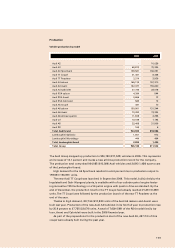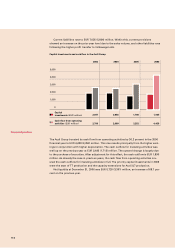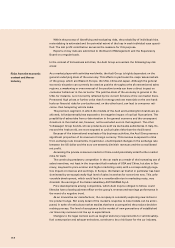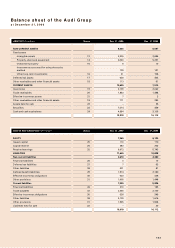Audi 2006 Annual Report Download - page 157
Download and view the complete annual report
Please find page 157 of the 2006 Audi annual report below. You can navigate through the pages in the report by either clicking on the pages listed below, or by using the keyword search tool below to find specific information within the annual report.
1 5 5
There are diverse risks within the context of the Audi Group’s operating activities which can
substantially undermine its financial position and financial performance.
These include major fires and explosions that, on the one hand, damage or destroy the
group’s assets and, on the other hand, may cause considerable consequential losses by
hindering the production process. Production hitches may take the form of disruptions to
the energy supply and technical disruptions, in particular to electronic data processing.
Although such occurrences could potentially lead to high losses, their likelihood is relatively
low. The group counteracts such risks through preventive measures such as fire protection
and by taking out adequate insurance cover.
The close, economically advantageous collaboration between car manufacturers and
suppliers that is customary in this industry is increasingly leading to interdependence. This
trend is gaining momentum as a result of the exclusive use of innovative technologies by
globally active suppliers. The risks arising from this are counteracted within the company
through appropriate contractual arrangements, and in particular through the retention of
ownership of tools by the Audi Group.
Delivery delays or non-delivery as a result of tool breakage, emergency losses and strikes
at suppliers or in the transport sector hamper the production process. A rise in the number
of crises at suppliers, in some cases leading to their insolvency, has been observed. The
risks of loss of income from the above factors are limited within the Audi Group by taking
out appropriate insurance cover and the use of suitable methods of selecting and monitor-
ing suppliers.
The complex product development process for new vehicles and components goes hand
in hand with risks from delays, from changes to the product at short notice and from the
loss of expertise as a result of the involvement of third-party service providers in the devel-
opment process.
Despite the presence of an efficient, systematic quality management approach within the
Audi Group, potential product liability risks cannot be entirely excluded. These can both
result in considerable financial losses to the company and also harm its image.
The financial risks to which the Audi Group is exposed as a result of its business activities
comprise market price risks (exchange-rate, interest-rate and price risks from commodities),
creditworthiness risks and liquidity risks.
As a result of its worldwide sales markets, the Audi Group is exposed to particular risks
from exchange-rate movements, above all of the US dollar and the pound sterling.
Detailed information on the hedging policy and on risk management in the area of finan-
cial risks, in particular in relation to the use of derivative financial instruments in hedging
transactions, is provided in the notes to the consolidated financial statements of the Audi
Group from page 197, in the chapter “Other particulars” under the item “Hedging policy and
risk management”.
Compared with the previous year, there is no substantial change in the risk situation of the
Audi Group.
The risks described harbour the potential to undermine the financial position and finan-
cial performance of the Audi Group to a significant degree. However, on the basis of all
known particulars and circumstances, there are currently no risks that can endanger the
company’s survival in the foreseeable future.
Risks from operating
activities
Financial risks
Overall assessment of the
risk situation
























